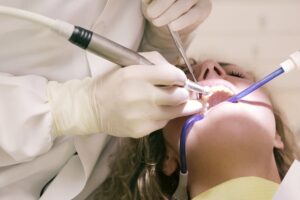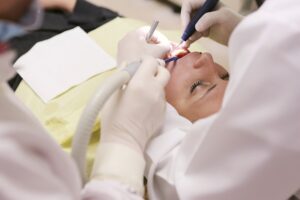7 Options To Fix A Broken Tooth

Teeth are an important asset that many of us underappreciate, this is made more apparent than ever when your teeth are damaged. This is why over time dental treatments have developed over time to correct teeth that are damaged by either plaque buildup or physical trauma to the mouth and teeth.
Each of the treatments within this article are tools that your dentist can use to ensure that you can achieve the best outcome for your smile.
Dental Crown
Dental crowns are a tooth shaped cap that restores a decayed, worn down, weak or damaged tooth. Dental crowns encase the entire tooth from the base of the crown to the flush that meets the gumline, because of this additional protection dental crowns are often the last resort for a damaged tooth that is past the point where veneers, onlays or fillings can help. Dental crowns are often built using metal, resin and porcelain; Dental crowns can last up to 15 years depending on the material used and how the dental crown is treated by the patient that received the dental crown.
Dental Crowns normally require two separate visits to the dentist, within the first visit the dentist will remove some of the natural enamel, which provides more leeway for a dental crown to fit over a tooth. Dentists may also use a filling material to build up certain parts of the tooth, this helps the dentist create a strong foundation for the crown. Then the dentist takes an impression of your tooth either using putty like material or with a dental scanner.
Dental crowns normally take two to three months to make so in the meantime they make a temporary crown which can be made on the same day. Temporary crowns are weaker than regular crowns meaning you should take extra care when eating. At your second dentist appointment, your dentist will remove the crown, and bond the new dental crown to your teeth with dental cement.
Veneers
Dental veneers, also known as porcelain veneers or dental porcelain laminates are wafer-thin tooth coloured layers that are placed onto the front surfaces of your teeth. Veneers are similar to false nails that cover a fingernail. Thinner veneers are used to mask stains and discolouration, whilst thicker veneers can offer the same benefits, they are used to cover parts of a tooth that may be broken, chipped or worn down. Dental veneers can be placed onto your tooth in a single dental visit, although in some cases it may take two separate visits to the dentist. You can get dental veneers at your dentist or by going to a cosmetic dental clinic.
Dental Implant
A dental implant is a metal implant inserted into the jaw to provide support for an artificial tooth that is screwed onto the implant. Dental implants are often used when a tooth has been damaged beyond repair; it could be that the tooth has rotted away due to dental plaque or there is a severe crack in the tooth that the dentist doesn’t feel confident fixing, at least without causing further damage to the tooth. Sometimes people may need to wait up to 6 months after a tooth extraction before their gums are healthy enough; as dental implants involve cutting into your gums to expose the bone and then drilling into the bone, where the dental implant metal post will be placed.
Composite Bonding
Dentists start the process of composite bonding by cleaning the patients teeth, they then roughen the tooth with an etching solution. The tooth is then dried and covered with a composite that has been colour matched with the patient’s tooth. After the composite is placed onto the tooth it is then shaped by the dentist and hardened with a curling light. Several more layers of composite are added to the tooth to increase the strength of the composite. The hardened composite is then polished by the dentist.
Root Canal
Root canal is where abscessed or infected pulp is removed from the tooth. In other words, the nerve of the tooth is removed. Nerves are pain receptors that are all over your body and are responsible for sending pain signals to your brain when you are doing something that is damaging to your body. Root canal is often used when there has been trauma to teeth, which may lead to teeth cracking or breaking apart; causing the pulp inside your tooth to be exposed. If the dentist does not perform a root canal in this circumstance the patient may be at risk of developing an infection of the broken tooth, which may lead to the patient losing the entire tooth and the infection spreading to other areas of the mouth and nose.
Filling
Dental fillings are a common fix to damaged teeth, as they provide a barrier between the inside of a tooth that may be cracked and the outside world. This means that food cannot land inside your tooth which would cause plaque and bacteria buildup inside your tooth. If food does land inside a crack in your tooth it may be very difficult to ensure you brush your teeth enough to compensate for this. Dental fillings are relatively quick and simple to apply. Prior to applying the filling the dentist will drill into the tooth to remove the decay which leaves a clean surface for the filling to be inserted onto.
Dental Sealants
Dental sealants are thin, protective coatings that protect and shield your back teeth from harmful bacteria that causes cavities. Once applied the dentist cures and hardens the sealant with a curling light. Dental sealants are made out of several different materials including resins (synthetic or plant) or glass ionomers (glass powder combined with a water-soluble acid). The process of applying dental sealants involves cleaning the teeth and drying them, then the dentist paints a small amount of dental acid etching solution to the chewing surfaces of the tooth to roughen them up. After this, the dentist dries your tooth and applies the sealant material onto the enamel of your tooth, a curling light is used to harden the sealant solution which bonds the solution to the enamel of the tooth.
Conclusion
There are a range of solutions for broken teeth, your dentist will be able to further advise you on which one of these options is most suitable for for your individual circumstances.






